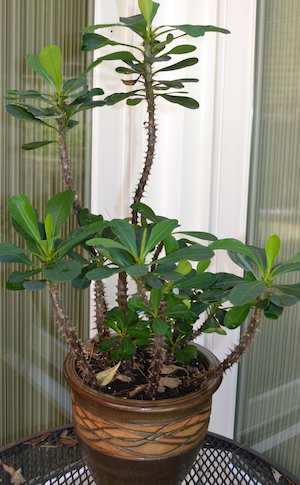A Thirty-Year Relationship
By Susan McCrackin, Fairfax Master Gardener Intern
About thirty years ago, I was in one of those down dips on the life roller coaster where I had a difficult time seeing that life would get better. During one of those days, I was at a grocery store and noticed this pathetic plant on a clearance cart placed close to the back door of the store. It was obvious that the next step for those clearance items was the trash. After standing and looking at that plant for a few minutes, I finally took it off the cart and put it in my basket. It really was in bad shape and probably closer to dying than to living.
 In an overly dramatic moment of my more youthful self, I struck a bargain with it — I would take it home and if it lived, so would I.
In an overly dramatic moment of my more youthful self, I struck a bargain with it — I would take it home and if it lived, so would I.
So, I took my fifty-cent plant (probably over-priced for the shape it was in) home. It was a Crown of Thorns, so it was not the easiest plant to care for. Replanting it required thick leather gloves, and I still suffered a few stabs. But the plant got a new home, and for me, my attention was focused on something other than myself.
Thirty years later, we are both still here.
I’ve been thinking about that experience lately as I lose myself in a brand-new vegetable garden. This past February, I finally got a garden plot in one of the community gardens and immediately started to weed and prep the garden for planting in the spring. Who knew then that our world would change so dramatically in the months to come with stay-at-home orders, close friends forced to be physically distant and the grocery shopping experience more like a treasure hunt of empty shelves in a high anxiety exercise? Our world became all about isolation and masks and hand sanitizers and distancing and fear.
Amid this madness, my garden became a place of normalcy and focus, and once again, plants saved my life. Well, at least my sanity. The garden, unlike the world, was unchanged. The plants grew — as normal. The plants bloomed — as normal. They needed watering and weeding — as normal. They produced fruit and demanded harvesting — as normal. Life, in the garden, was normal, and comfortable, and comforting.
The garden encouraged social interaction with plot neighbors but made those interactions safe. While working and visiting from within our own plots, we were distanced without conscious thought and certainly without fear.
The bounty I dreamed about in February and March as I worked to prep my garden became much more than the vegetables harvested. The bounty given by the garden was also the gift of immersing myself in a world that was like the one before the pandemic — a world that was before isolation and masks and hand sanitizers and distancing and fear.
A rescued plant three decades ago and a garden plot this year have provided grounding normalcy in a world gone mad. It seems that plants have played critical roles at important points in my life.
Sitting here, writing this, I can see that plant I bought thirty years ago. Then, it was a single struggling stem, working desperately to hold on to its few remaining leaves, the hint of a bloom dried on its top. Today, my Crown of Thorns is a vibrant plant of multiple leafy stems. I still need those heavy leather gloves to care for it, and occasionally, it stabs me pretty good. But I don’t care. We struck a bargain.